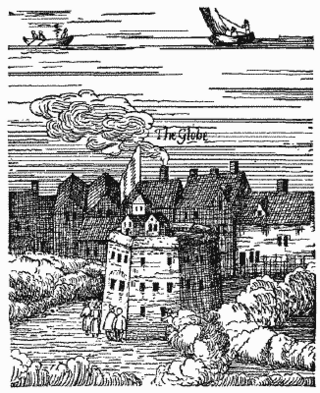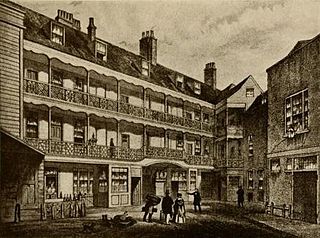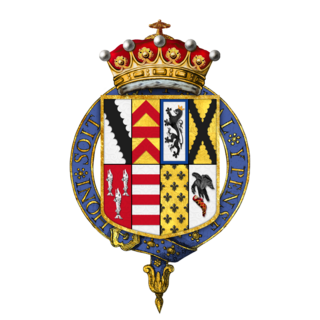Related Research Articles
Thomas Kyd was an English playwright, the author of The Spanish Tragedy, and one of the most important figures in the development of Elizabethan drama.

Titus Andronicus is a tragedy by William Shakespeare, believed to have been written between 1588 and 1593. It is thought to be Shakespeare's first tragedy and is often seen as his attempt to emulate the violent and bloody revenge plays of his contemporaries, which were extremely popular with audiences throughout the 16th century.
This article contains information about the literary events and publications of 1594.
Philip Henslowe was an Elizabethan theatrical entrepreneur and impresario. Henslowe's modern reputation rests on the survival of his diary, a primary source for information about the theatrical world of Renaissance London.

The Rose was an Elizabethan theatre. It was the fourth of the public theatres to be built, after The Theatre (1576), the Curtain (1577), and the theatre at Newington Butts – and the first of several playhouses to be situated in Bankside, Southwark, in a liberty outside the jurisdiction of the City of London's civic authorities. Its remains were excavated by archaeologists in 1989 and are listed by Historic England as a Scheduled Monument.
The Lord Chamberlain's Men was a company of actors, or a "playing company", for which William Shakespeare wrote during most of his career. Richard Burbage played most of the lead roles, including Hamlet, Othello, King Lear, and Macbeth. Formed at the end of a period of flux in the theatrical world of London, it had become, by 1603, one of the two leading companies of the city and was subsequently patronized by James I.
In Renaissance-era London, playing company was the usual term for a company of actors. These companies were organised around a group of ten or so shareholders, who performed in the plays but were also responsible for management. The sharers employed "hired men" – that is, the minor actors and the workers behind the scenes. The major companies were based at specific theatres in London; the most successful of them, William Shakespeare's company the King's Men, had the open-air Globe Theatre for summer seasons and the enclosed Blackfriars Theatre in the winters. The Admiral's Men occupied the Rose Theatre in the 1590s, and the Fortune Theatre in the early 17th century.
The Admiral's Men was a playing company or troupe of actors in the Elizabethan and Stuart eras. It is generally considered the second most important acting troupe of English Renaissance theatre.
The Earl of Pembroke's Men was an Elizabethan era playing company, or troupe of actors, in English Renaissance theatre. They functioned under the patronage of Henry Herbert, 2nd Earl of Pembroke. Early and equivocal mentions of a Pembroke's company reach as far back as 1575; but the company is known for certain to have been in existence in 1592. In that year, a share in the company was valued at £80.
Lord Strange's Men was an Elizabethan playing company, comprising retainers of the household of Ferdinando Stanley, Lord Strange. They are best known in their final phase of activity in the late 1580s and early 1590s. After 25 September 1593, they were known as the Earl of Derby's Men, that being the date of Stanley's accession to his father's title.
The Newington Butts Theatre was one of the earliest Elizabethan theatres, possibly predating even The Theatre of 1576 and the Curtain Theatre, which are usually regarded as the first playhouses built around London. William Ingram believes it was probably the first of the three to begin construction, and may have been the first completed.
The Earl of Worcester's Men was an acting company in Renaissance England. An early formation of the company, wearing the livery of William Somerset, 3rd Earl of Worcester, is among the companies known to have toured the country in the mid-sixteenth century. A later iteration of the company toured through the 1580s and '90s; little is known about its activities, though in 1583 it included the sixteen-year-old Edward Alleyn, at the start of his illustrious career.
Augustine Phillips was an Elizabethan actor who performed in troupes with Edward Alleyn and William Shakespeare. He was one of the first generation of English actors to achieve wealth and a degree of social status by means of his trade.
Thomas Pope, also credited as Thomas Poope in the First Folio, was an Elizabethan actor, a member of the Lord Chamberlain's Men and a colleague of William Shakespeare. Pope was a "comedian and acrobat."

William Sly was an actor in English Renaissance theatre, a colleague of William Shakespeare and Richard Burbage in the Lord Chamberlain's Men and the King's Men.
Francis Langley (1548–1602) was a theatre builder and theatrical producer in Elizabethan era London. After James Burbage and Philip Henslowe, Langley was the third significant entrepreneurial figure active at the height of the development of English Renaissance theatre.
Queen Elizabeth's Men was a playing company or troupe of actors in English Renaissance theatre. Formed in 1583 at the express command of Queen Elizabeth, it was the dominant acting company for the rest of the 1580s, as the Admiral's Men and the Lord Chamberlain's Men would be in the decade that followed.

In the historical era of English Renaissance drama, an Inn-yard theatre or Inn-theatre was a common inn with an inner courtyard with balconies that provided a venue for the presentation of stage plays.

Henry Radclyffe, 4th Earl of Sussex, KG was an English peer.

A Knack to Know a Knave is a 1592 play closely associated with the principal performers Edward Alleyn and William Kempe. The play is a comic morality tale designed to highlight the talents of the celebrated clown Kempe, and is known from one text, itself arguably a memorial reconstruction. The author is unknown, though the involvement of Robert Greene has been suggested, as well as George Peele and Thomas Nashe. Recent scholarship has argued for a Shakespearean connection. On the basis of traditional literary-critical analysis and digital textual methods, Darren Freebury-Jones has proposed that the case for Robert Wilson's authorship of A Knack to Know a Knave is compelling. The play gives an insight into the nature of Elizabethan theatre during Shakespeare's time and the relationship between playscript and extemporised comedy.
References
- ↑ F. E. Halliday, A Shakespeare Companion 1564–1964, Baltimore, Penguin, 1964; pp. 480-1.
- ↑ E. K. Chambers, The Elizabethan Stage, 4 Volumes, Oxford, Clarendon Press, 1923; Vol. 2, pp. 92-3.
- ↑ Scott McMillin and Sally-Beth MacLean, The Queen's Men and Their Plays, Cambridge, Cambridge University Press, 1998; pp. 5, 11-12.
- ↑ Chambers, Vol. 2, pp. 93-4.
- ↑ Chambers, Vol. 2, p. 94; Halliday, p. 481.
- ↑ Carol Chillington Rutter, Documents of the Rose Playhouse, Manchester, Manchester University Press, 1999; pp. 14-15, 19-20 and ff.
- ↑ Halliday, p. 408; Chambers, Vol. 2, p. 95.
- ↑ Halliday, pp. 496-7; Chambers, Vol. 2, pp. 122-3, 129-30, 202.
- ↑ Chambers, Vol. 2, p. 96.